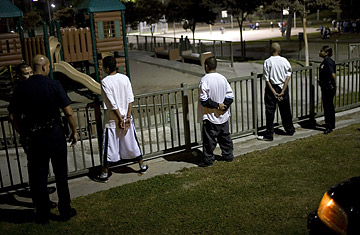
Los Angeles Police Department gang unit officers question and search confirmed MS-13 street gang members in the Rampart area of Los Angeles, California.
How much power do genes hold over behavior? Can they predict, for example, whether a child will grow up to join a gang? Those are among the questions raised by a new Florida State University (FSU) study released June 5. (What Can Genetic Tests Tell You?)
Since the early 1990s, science has suggested a link between antisocial behavior and a defect in the gene that codes for an enzyme called monoamine oxidase A (MAO-A). A low level of activity on the MAO-A gene results in an excessive breakdown of neurotransmitters, such as serotonin, which helps keep humans calm and happy. The defect thereby increases the urge to react aggressively to threats or fears, leading MAO-A to be referred to as the "warrior" gene. (See 20 ways to get and stay happy.)
The latest research, however, takes the association one step further. It is the first to link low activity on the MAO-A allele in young men both to an increased likelihood of joining a gang and to a greater tendency to use weapons and violence. "For the first time, we were able to establish a direct connection between the MAO-A gene and the choosing of a violent lifestyle," says Kevin Beaver, a biosocial criminologist at FSU and lead author of the study published in Comprehensive Psychiatry.
Researchers used DNA data and self-reported lifestyle surveys from nearly 2,500 participants in the National Longitudinal Study of Adolescent Health, the largest and most comprehensive survey of health-related behavior among adolescents between 7th and 12th grade, which started in 1994. Slightly more than half of the study's male participants had low-level activity on the MAO-A gene, and about 3% of the total pool reported having joined a named gang in the past year. (See pictures of gangs in New Zealand.)
Beaver and his colleagues found that those males carrying the low-active MAO-A gene were nearly twice as likely to join an organized gang than males with the high-active gene, and when in a fight, they were nearly twice as likely to brandish a weapon. Of the gang members studied, those who had a low-activity MAO-A allele were more than four times more likely to use a weapon when compared with male gang members who carried a high-activity version of the allele. "At the very least this suggests a genetic risk factor that can help us identify those youth most at risk," Beaver says. "We can then intervene earlier to prevent it."
Indeed there's little doubt that violence is the result of an uneasy mix between bad genes and a bad environment. How much control nature has over nurture, however, is the question. Previous studies of the MAO-A gene suggest that interplay may begin in early childhood. A British study of 442 New Zealand men, published in 2003, was among the first to find that those with a low-active MAO-A gene, who had been abused as children, were four times more likely to have committed rapes, robberies and assaults than the general population. Those with high-active MAO-A genes, moreover, appeared to be immune to childhood mistreatment, turning out to be no more or less violent than average. Men with low-active genes who were not the victims of child abuse were slightly less antisocial than average.
"What all these risk gene studies show us is that genes do an important job in loading the gun," says Joshua Buckholtz, a neuroscience Ph.D. candidate at Vanderbilt University's Brain Institute and Department of Psychology, who has written extensively about MAO-A gene. "But it's the environment that pulls the trigger."
